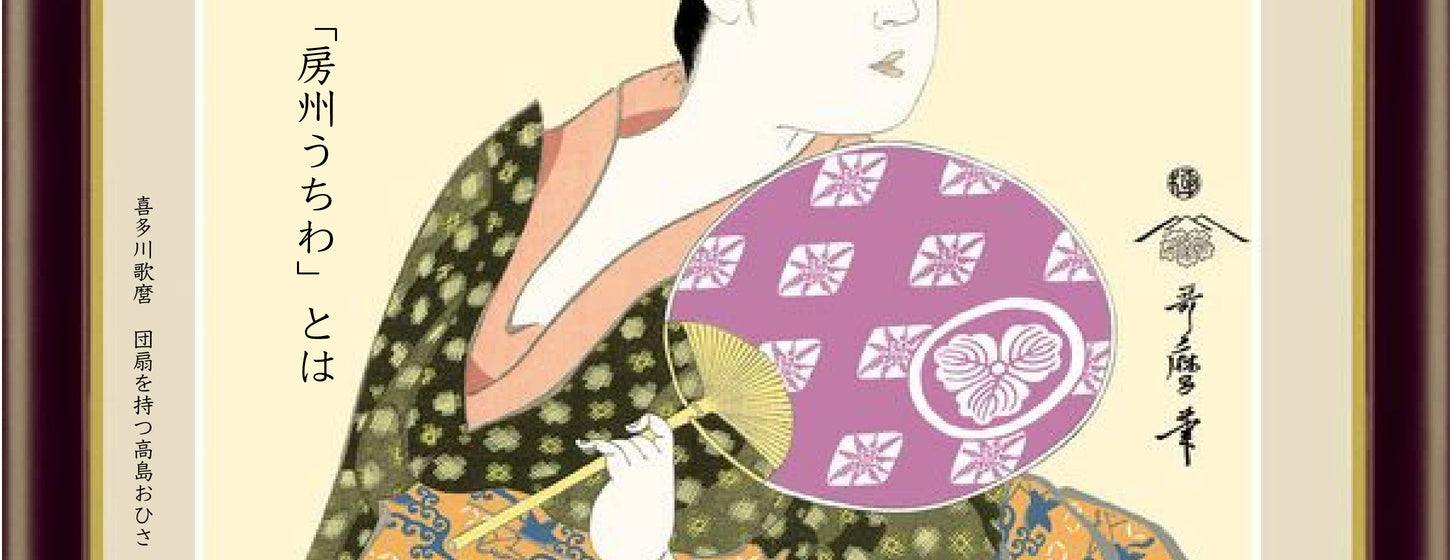

History of Bōshū Uchiwa Fans
Uchiwa fans were introduced to Japan from China during the Nara period (710–794). Originally, they were used by the nobility to conceal their faces, maintain a dignified appearance, or ward off insects.
It was during the Edo period (1603–1868) that uchiwa fans became more widely available to the common people. They were recognized as essential tools for daily life, used for cooling off in the summer and for stoking fires while cooking.
◆房州うちわの歴史
奈良時代に中国から伝来したうちわは高貴な人が顔を隠し自らの威儀を正すためや、虫をはらうための道具として使用されていました。
庶民の手に渡り始めたのが江戸時代。暑さしのぎのため、炊事の際の火起こしのために扇ぐなど、日常生活の道具として認識されていました。

During the Edo period, many merchants in Nihonbashi, Edo (modern-day Tokyo) began producing uchiwa fans. This led to the creation of Edo Uchiwa, the predecessor of Bōshū Uchiwa.
The image shown is "Firefly Hunting" by Kitagawa Utamaro. As seen in such artwork, uchiwa fans were an essential part of everyday life for common people at the time.
The Bōshū region, with its warm climate, is home to naturally growing medake bamboo, known for its flexibility. The round-handled uchiwa fans were crafted using this bamboo. Initially, the raw bamboo materials were shipped by boat to Edo, where artisans would turn them into finished fans.
In 2003, Bōshū Uchiwa became the first traditional craft in Chiba Prefecture to be officially recognized as a Traditional Handicraft by the Minister of Economy, Trade, and Industry. Alongside Kyō Uchiwa from Kyoto and Marugame Uchiwa from Shikoku, it is regarded as one of Japan’s three major traditional uchiwa fans.
Over time, both daily life and the use of uchiwa fans have evolved. What was once a mass-produced household item has now developed into a refined work of craftsmanship, continuously reaching new levels of excellence.
「房州うちわ」は平成15年に千葉県で初めて経済産業大臣指定伝統的工芸品として認定され、京都の「京うちわ」四国の「丸亀うちわ」とともに、日本三大うちわのひとつとして伝統を受け継いでいます。
時代と共に生活もうちわの使われ方も変化しました。うちわは大量生産の日用品から工芸品と発展し、更なる極みへと至ろうとしています。
Bamboo as a Material
Bamboo, the primary material for uchiwa fans, remains lush and green throughout the year, even in the cold of winter, without shedding its leaves. Growing straight toward the sky and enduring the weight of snow, bamboo is revered as a symbol of resilience and vitality.
◆素材としての竹
素材となる竹は寒い冬でも葉を落とさず、一年中青々。天に向かって真直ぐに伸び、雪が降っても重みに耐えうる生命の象徴とされています。

Bamboo grows rapidly, reaching full height in just three months, symbolizing vitality and growth. Its deep-rooted underground network allows it to sprout new shoots (takéno-ko) each year, representing prosperity and the continuation of generations.
Additionally, bamboo is considered sacred, as it is always used in Shinto rituals, further emphasizing its spiritual significance.
The bamboo used for Bōshū Uchiwa is called "medake" (女竹, also known as shinodaké). As its name suggests, medake possesses a flexible, resilient quality, much like the grace and strength often associated with femininity. This unique suppleness of medake creates a gentle, soothing breeze when used in an uchiwa fan.
竹はわずか三ヶ月で成長することから成長力旺盛であること、そして地下に根を張り毎年どんどん伸びていき、筍(たけのこ)を伸ばすことから「子孫繁栄」を意味します。
尚、神事には必ず使用されることから神聖な存在であることが分かります。
房州うちわに使用する竹は「女竹(めだけ ※別名篠竹)」と呼ばれ、名前に女が入るように、竹の種類の中でも女性の様に粘りがあり、しなやかな特徴があります。女竹にしかない「しなやかさ」がやさしい風を生み出します。
Bōshū Uchiwa Crafted by Chikuboshi
Bōshū Uchiwa fans are crafted from a single piece of bamboo, allowing them to flex naturally across their entire surface. This unique structure creates their most distinctive feature—a soft, gentle breeze. With each fan, I put my heart into the craftsmanship, always mindful of the wind and the comfort it brings to the person who holds it.
While there are several workshops producing Bōshū Uchiwa in Chiba Prefecture, at Chikuboshi, every step of the process—from harvesting the bamboo to the final product—is done in a single workshop. This ensures that each fan is crafted with uncompromising dedication, allowing customers to feel a deep connection to the piece they hold in their hands.
Harvesting bamboo is more than just sourcing materials—it allows the wind to flow through the bamboo grove, promoting the growth of stronger, healthier bamboo for the future and helping to preserve the satoyama landscape. At Chikuboshi, we believe that bamboo is much like people: when the surrounding environment is well-tended, sunlight can reach within, nurturing bright, straight-growing bamboo.
A well-maintained bamboo grove carries a mystical atmosphere, offering a place of peace and renewal. By reducing neglected bamboo groves and passing down beautiful, thriving forests to future generations, we hope to honor the deep connection between bamboo, nature, and craftsmanship.
Take a moment to pause in your day.
Let yourself be embraced by the comforting, gentle breeze of a Bōshū Uchiwa.
◆竹星がつくる「房州うちわ」
「房州うちわ」は“一本の竹”から作られているため全面でしなります。その最大の魅力は「ふんわりとやさしい風」が生み出されることです。風を意識して心を込めて、手にする人の気持ちに寄り添っていくようなうちわ作りを行っています。
県内に「房州うちわ」の工房はいくつかありますが、竹星では製作にあたっては愛着を持って手にとって頂けるように、竹の伐り出しから全ての工程を妥協することなく、一箇所の工房で一貫製作行い販売をさせていただいております。

竹の伐り出しは竹林に風を迎え入れ、次に育つより良い竹の育成に繋がり、里山の景観を守ります。竹星は竹も人に通ずると考えています。周りの環境を整えてあげることで陽の光が差し込み、明るく真っ直ぐな竹が育ちます。
手の入った竹藪は神秘的な空気が漂い、不思議と心が洗われる場所となります。管理が行き届かない竹藪を減らし、美しい竹林として後世へと引き継ぎたい。これが竹星の想いです。
日々の中でちょっとひとやすみ
心地よいやさしい風に包まれてください。
送料:全国一律1,000円〜
お支払い方法
クレジットカード: Visa, MasterCard, Maestro, American Express.
返品について
商品到着日を含み8日以内の返品を受け付けております。


